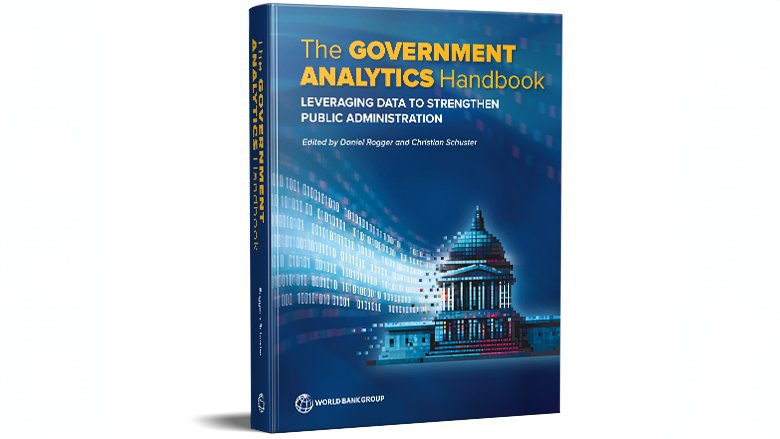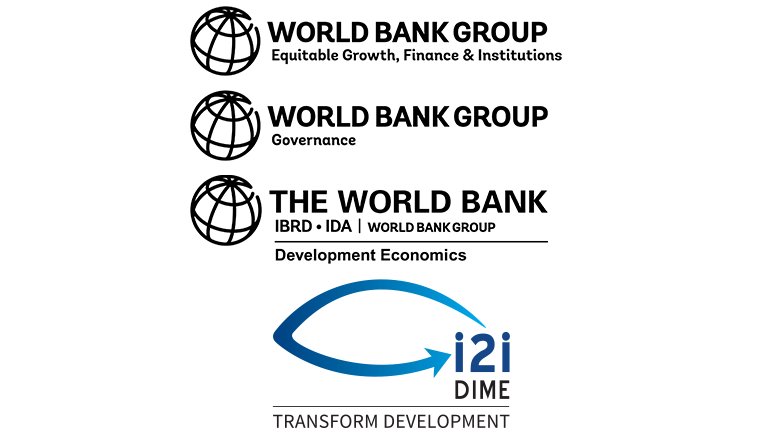PART 3. Government Analytics Using Administrative Data
- Home
- Overview
- Foundations
- Administrative Data
- Public Servants Surveys
- External Assessments
Chapter Summaries
-
Chapter 9. Creating Data Infrastructures for Government Analytics
Khuram Farooq and Galileu Kim
The use of data analytics in the public sector requires reforming management information systems (MIS) and data infrastructures. This chapter outlines a roadmap to guide practitioners in the development of analytically driven data infrastructures, drawing on the experience of World Bank practitioners and government officials. The conceptual framework and cases presented focus on Human Resource Management Information Systems (HRMIS), a foundational data infrastructure that provides information on personnel and compensation. The chapter first provides a conceptual framework and HRMIS reform toolkit, outlining key decision points and trade-offs involved. It then demonstrates how this framework can be applied in practice, drawing on case studies of analytical transformations in HRMIS systems in Luxembourg, Brazil, and the United States.
- Chapter 9.1 . Ludwig Balmer, Marc Blau, Danielle Bossaert
- Chapter 9.2 . Luciana Andrade, Galileu Kim, Matheus Soldi Hardt
- Chapter 9.3 (EVS ART). Robin Klevins and Camille Hoover
-
Chapter 10. Government Analytics Using Human Resources and Payroll Data
Rafael Alves de Albuquerque Tavares, Daniel Ortega Nieto, and Eleanor Florence Woodhouse
We present a microdata-based approach for governments to improve their strategic human resource management and fiscal planning. Using a series of examples from Latin American countries, we demonstrate how some basic statistics created using payroll and human resource management data can help policy-makers gain insight into the current and future state of their government's wage bill. We argue that this constitutes an important first step towards tapping the potential of existing bodies of payroll and human resource microdata that are currently underused. We believe that our approach can help policy-makers make difficult decisions by breaking down the causes of problems and putting numbers to the ways in which certain policy choices will translate into longer term consequences.
-
Chapter 11. Government Analytics Using Expenditure Data
Moritz Piatti-F¨¹nfkirchen, James Brumby, and Ali Hashim
Government expenditure data holds enormous potential to inform policy around the functioning of public administration. It¡¯s appropriate use for government analytics can help strengthen the accountability, effectiveness, efficiency, and quality of public spending. This chapter reviews where expenditure data come from, how they should be defined, and what attributes make for good quality expenditure data. The chapter offers policy makers an approach to reviewing the adequacy and use of government expenditure data as a means to strengthen the effectiveness of government analytics that build on these data. Case studies are used to illustrate how this can be done.
-
Chapter 12. Government Analytics Using Procurement Data
Serena Cocciolo, Sushmita Samaddar, and Mihaly Fazekas
The digitization of national public procurement systems across the world has opened enormous opportunities to measure and analyze procurement data. The use of data analytics on public procurement data allows governments to strategically monitor procurement markets and trends, to improve the procurement and contracting process through data-driven policy making, and to assess the potential trade-offs of distinct procurement strategies or reforms. This chapter provides insights into conducting research and data analysis on public procurement using administrative data. It provides an overview of indicators and data sources typically available on public procurement and how they can be used for data-driven decision-making, the necessary data infrastructure and capacity for optimizing the benefits from procurement data analytics, and the added value of combining public procurement data with other data sources. Governments can take various steps to create the conditions for effectively using data for decision-making in the area of public procurement, such as centralize public procurement data, periodically assess their quality and completeness, and build statistical capacity and data analytics skills in procurement authorities and contracting entities.
-
Chapter 13. Government Analytics Using Data on the Quality of Administrative Processes
Jane Adjabeng, Eugenia Adomako-Gyasi, Moses Akrofi, Maxwell Ampofo, Margherita Fornasari, Ignatius Geegbae, Allan Kasapa, Jennifer Ljungqvist, Wilson Metronao Amevor, Felix Nyarko Ampong, Josiah Okyere Gyimah, Daniel Rogger, Nicholas Sampah, and Martin Williams
This chapter seeks to highlight the value of quantifiable measures of the quality of back-office processes when assessing governments' bureaucratic effectiveness. Conceptually, it defines a framework for understanding administrative `process productivity'. It then presents case studies from the Ghanaian and Liberian civil service, where different measures of internal (within bureaucratic units) versus external (across bureaucratic units) quality of processes were piloted. Specifically, these pilots sought to assess the feasibility, cost, and scalability of the process measures considered. We explore their correlations with other measures of productivity (e.g., financial expenditures and the completion of planned tasks) and claims and characteristics of civil servants in the surveys we have undertaken.
-
Chapter 14. Government Analytics Using Customs Data
Alice Duhaut
Many government agencies have multi-dimensional missions, in which achieving one objective can reduce attainment of another organizational objective. This presents particular challenges to government analytics. Incomplete measurement of objectives risks encouraging attainment of measured objectives while unknowingly impairing other objectives. This chapter showcases how government analytics can be applied in such contexts, using the example of customs agencies. Customs agencies typically have three core objectives: facilitating trade, collecting revenue, and insuring the security and safety of the goods entering or exiting the country. Attaining one objective (e.g. greater safety of traded goods) can come at the expense of another (e.g. facilitating trade). This puts a premium on effective measurement of all dimensions of a customs mission, which requires triangulating different data sources. This chapter showcases how this can be done, deriving indicators for (1) trade facilitation (e.g. costs of the process, in particular time delays); (2) revenue collection (e.g. trade volume and revenue collected based on the assessed value); and (3) safety (e.g. number of goods in infraction seized). The chapter also underscores how a wider use of the customs database itself could help measure performance, combining it with other data collection methods such as time release studies (TRS) and exciting developments in GPS tracking data.
-
Chapter 15. Government Analytics Using Administrative Case Data
Michael Carlos Best, Alessandra Fenizia, and Adnan Qadir Khan
Measuring the performance of government agencies is notoriously hard due to the lack of comparable data. At the same time, governments around the world generate an immense amount of data that detail their day-to-day operations. In this chapter we focus on three functions of government that represent the bulk of their operations and that are fairly standardized: social security programs, public procurement, and tax collection. We discuss how public sector organizations can use existing administrative case data and re-purpose them to construct objective measures of performance. We argue that it is paramount to compare cases that are homogeneous or construct a metric that captures the complexity of the case. We also argue that the metrics of government performance should capture both the volumes of services provided as well as their quality. With these considerations in mind, case data can be at the core of a diagnostic system with the potential to transform the speed and quality of public service delivery.
-
Chapter 16. Government Analytics Using Machine Learning
Sandeep Bhupatiraju, Daniel Chen, Slava Jankin, Galileu Kim, Maximilian Kupi, and Manuel Ramos Maqueda
The use of machine learning and artificial intelligence offers new opportunities for improving the productivity of the public sector. Advances in data collection and algorithmic learning can facilitate the completion of tasks and increase efficiency, but the deployment of these solutions requires careful implementation. Similarly, these activities can facilitate improved diagnostics of the characteristics and dynamics of public administration. In the justice system, the increasing digitalization of legal documents and the development of new techniques in natural language processing (NLP) is opening new fields for the development of ML techniques for both improved case processing as well as understanding the nature of the judicial process. This chapter provides an overview of the different potential applications of ML in the public sector in general and in the justice system specifically, as well as discussing the development of the required infrastructure, both in terms of digital skills and data management. It then analyzes the case of ML deployment in India, discussing the challenges of implementation and its potential benefits.
-
Chapter 17. Government Analytics Using Data on Task and Project Completion
Imran Rasul, Daniel Rogger, Martin Williams, and Eleanor Florence Woodhouse
Much government work consists of the completion of tasks, from creating major reports, to undertaking training programs and building infrastructure. This chapter surveys a range of methods for measuring and analyzing task completion as a measure of the performance of government organizations, giving examples of where these methods have been implemented in practice. We discuss the strengths and limitations of each approach from the perspectives both of practice and research. While no single measure of task completion provides a holistic performance metric, when used appropriately they can provide a powerful set of insights for analysts and managers alike.
News and Events
Handbook Teaser Trailer
-
SPONSORS
A collaboration between the Development Impact Evaluation Department, Office of the Chief Economist of Equitable Growth, Finance and Institutions.
Chapters
Part 1: Overview
Chapter 1:?
Chapter 2:?
Chapter 3:?
?
Part 2:?Foundational Themes in Government Analytics
Chapter 4:
Chapter 5:
Chapter 6:
Chapter 7:
Chapter 8: ??
?
Part 3: Government Analytics Using Administrative Data
Chapter 9:
Chapter 10:?
Chapter 11:?
Chapter 12:
Chapter 13:
Chapter 14:?
Chapter 15:?
Chapter 16:?
Chapter 17:
?
Part 4: Government Analytics Using Public Servant Surveys
Chapter 18:
Chapter 19:?
Chapter 20:?
Chapter 21:?
Chapter 22:?
Chapter 23:?
Chapter 24:?
Chapter 25:?
Chapter 26:?
?
Part 5: Government Analytics Using External Assessments
Chapter 27:
Chapter 28:
Chapter 29:
Chapter 30:










